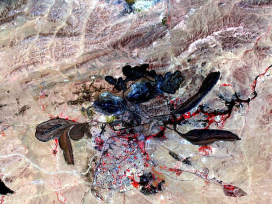Spelling out a law for nature
How to squeeze civilizational change into precise legal frameworks
As police carry away protesters blocking oil carriers, a very detailed and technical debate is unfolding about the framework to introduce the notion of ecocide in international criminal law. Social scientists and legal experts debate the approach, and Victor Tsilonis cautions them to always consider practical applications.
‘Judge to be judged’
Manolis Anagnostakis
The institutions of international law are the most anthropocentric project possible. But now, on the brink of civilizational collapse, ecological destruction forces us to introduce the perspective of the natural environment into this behemoth. Theoretical debates range far and wide, and although they seem very abstract, their effects will define the fates of generations – of humans as well as other living beings. So how can we reconcile the complexity of humans’ effect on nature, with the very structured requirements of actionable legal systems?
Setting up a new International Criminal Court for the Protection of the Environment (ICCPE) is absolutely essential in the realm of public international law in order to effectively face all the serious legal challenges linked to the rampant destruction of the environment for the sake of profit. The ongoing legal debate is inevitably technical, reaching the core of the legal theory of (international) criminal law. Nonetheless, what often proves to be most problematic is the rapid shift in legal experts’ views from accepting the urgent need for the establishment of a new International Criminal Court for the Protection of the Environment (ICCPE), to adhering to more conventional views. That is, the underfunded, under-resourced International Criminal Court, already burdened with more cases than it can handle, should also be the ‘appropriate’ legal institution for addressing the criminal destruction of our planet.
In whose name?
In his exquisite article How democracies die, fast and slow, John Keane notes that
the slowest form of democide – caused by the destruction of the living planetary environments in which humans dwell – should be the most worrying for democrats of all persuasions everywhere… As if Earth’s revenge against its human destroyers, environmental shocks are sometimes marked by frightening quantum qualities that display a will of their own.
Keane points out that while ‘disasters can bring out the best in citizens’, we should not forget that environmental catastrophes can also destroy the foundations of democracy.
In line with Keane, Rafi Youatt underlines how ‘obvious, perhaps, is how each crisis is connected to a deeply rooted, hydra-headed anthropocentrism’, because
anthropocentric ideas and practices nonetheless matter greatly in both the crisis of democracy and the crisis of the planet.
Youatt argues that both the planet and democracy are in peril due to deeply rooted anthropocentrism, which views humans as superior and central. This then results in political injustice and ecological destruction.
The author dismisses the idea that extending more rights to nonhuman nature can solve the problem. Instead, Youatt suggests that the human, in political and democratic contexts, should be seen as an ecologically embedded being rather than an exclusively rational, liberal subject.
In his response, How democracies transform, fast and slow, Ferenc Laczó questions the narrative of ‘the adagissimo version of democide’ which, according to Keane, would lead to the collapse of democracy ‘via the despoliation of our planet and ecological shock’ advanced by John Keane.
He also expresses concern about whether democracies are capable of adequately addressing urgent issues like climate change.
Channelling complexity into legal action
Similar to Ferenc Laczó’s harsh critique, many scholars and experts have been equally or even harsher critics of the definition of ecocide, as proposed by the International Experts Panel (IEP). Kevin Jon Heller had eagerly anticipated the proposed definition, only to turn sceptical, partly because the commentary, in many respects, failed to describe the mens rea of ecocide. It also did not provide a satisfactory explanation as to why the IEP did not recommend ecocide to be considered a crime.
Darryl Robinson highlighted ‘why combining international criminal law (ICL) with international environmental law (IEL) raises fascinating novel challenges that are not initially evident to those of us trained in ICL’, as well as why
there is no elegant “magic bullet” solution.
Kai Ambos has stressed that the IEP proposal lacked robust reasoning and practical guidance to introducing ecocide as a fifth core international crime, alongside genocide, crimes against humanity, war crimes, and the crime of aggression. Although intended to protect the environment, the proposal did not provide empirical data to support its effectiveness, while it remained unclear whether serious environmental crimes could amount to genocide.
Moreover, the proposal’s structure mimicked that of crimes against humanity, but extended it to peace times and expanded its applicability. The practical application posed great interpretive challenges, prompting doubts about the necessity of a new, stand-alone core crime for environmental protection.

Justitia atop the Gerechtigkeitsbrunnen in Biel, Switzerland. Photo by Roland Zumbuehl via Wikimedia Commons.
Preventative justice
Tarini Mehta has pointed out that a strong case exists for the adoption of ecocide as a strict liability offence under international criminal law. She argues this would impose a more stringent duty of care on corporations whose activities cause environmental harm, thereby deterring and holding accountable those who degrade the environment.
This approach, already advocated by several commentators, challenges the traditional fault-based liability under international law. Despite existing legal frameworks, Mehta supports a shift from a ‘polluter pays’ principle to a ‘polluter no longer pollutes’ system, which could offer a preventative justice solution.
As the rate of biodiversity loss and environmental degradation continues to increase, while ‘over half of the global GDP – amounting to around US$44 trillion – is moderately or highly dependent on ecosystem services’, Mehta vehemently endorses that evolving the law to meet these challenges is not just beneficial, but absolutely essential. Recognising ecocide as a crime at national, regional, and international levels, she concludes, could be a vital step towards the protection of the environment.
Michael Κarnavas has perhaps written the most colourful account of a great set of raised objections ranging from the to more serious issues. These revolve around the terminology of ‘ecocide’, the drafting process, the impracticability of having a fifth crime within the Rome Statute, the ICC judges’ ability to assess complex environmental crimes, the singularities of the damage threshold in ecocide, the critical flaws of the description of the mental state required for committing ecocide (mens rea), and the utterly problematic description of the concrete actions that constitute this crime (actus reus).
To sum up Michael Κarnavas’ mixed views, while he is generally in favour ‘of drafting a concise and well-founded definition of crimes against the environment in times of peace/non-armed conflict situations’, he concurrently considers ‘the initiative as unrealistic, the definition replete with flaws, and the commentary remarkably wanting’.
Similarly, Matthew Gillett seems to have taken great inspiration from Charles Dickens’ classic novel ‘The Tale of Two Cities’ in his two-part article published in Opinio Juris. Titled ‘A Tale of Two Definitions: Fortifying Four Key Elements of the Proposed Crime of Ecocide’ (here and here), Gillett enumerates several suggested flaws of the ecocide definition proposed by the Independent Expert Panel (‘IEP’) in 2021.
The first flaw he advances is the absence of enumerated acts that should be considered as ecocide, since this lack is in deep contrast ‘with the structure of all existing crimes under the Rome Statute’. According to the author, this is a fatal flaw, since it violates the principle of legality. It also contradicts the findings of the European Court on Human Rights’ decision in the case of 1 and disregards the relevant findings of the United Nations Working Group on Arbitrary Detention that criminal laws should be ‘formulated with sufficient precision’, because imprecise offences do not allow individuals to regulate their conduct accordingly, jeopardize the exercise of their fundamental rights, and ‘are likely to result in arbitrary deprivation of liberty’.
In his book Prosecuting Environmental Harm Before The International Criminal Court, he suggests a definition that lists wilfully committed offences that severely damage the natural environment over the long term and/or on a widespread basis. The cases include destroying natural heritage, dumping hazardous substances, large-scale emissions and more.2
What it takes to perform that justice
There are several objections to this definition and its underlying rationale. Firstly, Gillett assumes from the beginning and throughout his two-part article that the International Criminal Court (ICC) is unquestionably the most suitable legal institution for prosecuting ecocide. However, he does not consider the practical limitations of the ICC, including its limited human resources, financial constraints, existing trial workload, projected future trials (such as the ongoing war of aggression in Ukraine), and overall legal capacity.
These factors are, however, must be considered before designating the International Criminal Court as the appropriate legal institution for trying ecocide.3
Moreover, the provisions Gillett’s proposed definition pose significant problems. The author suggests that ‘conduct shall not be considered ecocide if it is both
(a) strictly in accordance with international law, particularly international environmental law, and
(b) authorized by a competent national authority.’
The reasoning behind this caveat is unclear, but it appears that the author assumes that most or all states are democratic, uncorrupted, and genuinely concerned about the environment.
In other words, when a project gets approved or authorised by a legal authority, both lay people and legal experts may view this as a guarantee that it is safe for the environment and lawful for the individuals and entities conducting the project. The approval can seem like an ‘untouchable’ green light given by the state authority. This action is often perceived to be in line with international law, even if the actual adherence to international law may sometimes be rather unclear or vague.
However, this assumption often does not align at all with reality. It is not necessarily true that an approved project is completely safe for the environment or entirely lawful for those conducting it. Therefore, it is essential to closely examine each project – and each of its aspects that could raise environmental concerns – regardless of whether it has been authorised by a state authority.
To name but one recent example, the fact that Japan intends to release approximately 1.3 millions of tons of water with tritium from the destroyed Fukushima Daiichi nuclear power plant has raised significant environmental concerns from neighbouring states, environmental organisations and civil society. Admittedly, before the Japanese state being able to release such an enormous amount of ‘treated’ water, about the volumeof 500 Olympic-sized swimming pools, it first needed authorisation from the competent Japanese authority and then also permission from the International Atomic Energy Agency, in accordance with international law. Nonetheless, given the grave potential consequences of such an action, as well as the adverse reactions from a wide range of actors (individuals, organisations and states) it still a valid question whether such an act could amount to actual ecocide, even despite all granted permissions. However, according to Gillett’s proposed definition, such an action could never be prosecuted.
Furthermore, it is indisputable that Gillett takes this leap well after the publication of his aforementioned textbook where, in stark contrast with his latest two-part article in Opinio Juris, he candidly states that ‘[i]nstead of exclusively trying to adjust the ICC’s provisions and principles to try to cover environmental harm, there is considerable merit in developing a purpose-designed international court for the environment (ICE), able to address and provide legal redress for all major forms of serious environmental harm threatening the planet, while doing so efficiently and through fair but flexible proceedings’.4This change of heart may be based in faith for the ICC, but it doesn’t address the crucial question of how a court will have the resources to take up a whole new area of jurisdiction, and effectively pursue it for the common good.
In all fairness
One shouldn’t be too harsh on academics, who put forth their best efforts to change our understanding of international, even though they don’t adequately address all possible aspects. But it is equally problematic to simply assume that the International Criminal Court is best suited for trying ecocide. This perspective overlooks the ICC’s current challenges and inherent limitations. Law, however universal, must always carry regard for practical realities – otherwise, it remains a futile endeavour.
This hasty approach to critique brings to mind Wystan Hugh Auden’s poem, Leap Before you Look, which was inspired by Kierkegaard’s work Leap of Faith:
Much can be said for social savoir-faire,
But to rejoice when no one else is there
Is even harder than it is to weep;
No one is watching, but you have to leap.
Kokkinakis v Greece was a case concerning primarily Article 9 of the European Convention of Human Rights (freedom of thought, conscience and religion), since pursuant to this article “1. Everyone has the right to freedom of thought, conscience and religion;” and “2. Freedom to manifest one’s religion or beliefs shall be subject only to such limitations as are prescribed by law…” Hence in this case the European Court of Human Rights found a violation of Article 9 because “in their reasoning the Greek courts established the applicant’s liability by merely reproducing the wording of section 4 and did not sufficiently specify in what way the accused had attempted to convince his neighbour by improper means. None of the facts they set out warrants that finding. That being so, it has not been shown that the applicant’s conviction was justified in the circumstances of the case by a pressing social need. The contested measure therefore does not appear to have been proportionate to the legitimate aim pursued or, consequently, "necessary in a democratic society ... for the protection of the rights and freedoms of others" (para. 49 of the decision).
The proposed definition in its entirety from Matthew Gillett, Prosecuting Environmental Harm Before the International Criminal Court, Cambridge, 2022, p. 350.
1. Ecocide means wilfully committing any of the following acts and thereby causing severe damage to the natural environment that is also widespread or long-term:
a) killing, harming, or removing protected flora or fauna;
b) destroying or damaging ecosystems or wild animal habitats;
c) destroying or damaging natural heritage;
d) trafficking or dumping hazardous substances;
e) releasing, emitting, or introducing harmful quantities of substances or energy into the air, water, or soil;
f) causing or contributing to the large-scale emissions of greenhouse gases or the destruction of greenhouse gas sinks or reservoirs;
g) any other acts of a similar character, where those acts involve unsustainable harm to the natural environment.
2. Irrespective of whether it qualifies as any of the acts listed in paragraph 1, conduct shall not be considered ecocide if it is both (a) strictly in accordance with international law, particularly international environmental law, and (b) authorized by a competent national authority.
3. In order to fulfil the definition in paragraph 1, the damage to the natural environment must be severe, while also being either widespread or long-term (or both).
Consequently, in all cases the anticipated damage must be severe, but no one of the qualifiers can be significant enough on its own to satisfy the definition of ecocide.
Moreover, the severe, widespread, and/or long-term nature of the harm may be established on the totality of the conduct at issue, which may include multiple underlying acts.
4. The terms of paragraph 1 shall be interpreted in accordance with international law, particularly environmental law.
See the last section of the Ecocide Chapter in Victor Tsilonis, The Jurisdiction of the International Criminal Court, Springer 2023 (2nd edition)
Matthew Gillett, Prosecuting Environmental Harm Before the International Criminal Court, Cambridge (Cambridge, 2022) p. 354.
Published 31 July 2023
Original in English
First published by Eurozine
© Victor Tsilonis / Eurozine
PDF/PRINTPublished in
In collaboration with
In focal points
- Living dead democracy
- Why Parliaments?
- Spelling out a law for nature
- No more turning a blind eye
- The end of Tunisia’s spring?
- Protecting nature, empowering people
- Albania: Obstructed democracy
- Romania: Propaganda into votes
- The myth of sudden death
- Hungary: From housing justice to municipal opposition
Newsletter
Subscribe to know what’s worth thinking about.
Related Articles

Mineral rush
Topical: Critical raw materials
Why does peace in Ukraine hang on a ‘mineral deal’ whose handling is more reminiscent of trade than negotiations? Perhaps because the global race for critical raw material mining is well and truly underway, digging for today’s equivalent of gold: raw earth elements and lithium critical for renewables and digital technology but also modern weaponry.

Excitement over ‘rare’ elements
Julie Klinger in conversation with Misha Glenny
The race for green transition supplies is on. But where’s the thrill in metals, discreet and hidden yet widespread? Mining, intensive due to low concentrations, throws up waste elements like arsenic. Space cowboys and deep-sea dredgers contest environmental stability more than China’s monopoly, based on 40-years of involved processing. Health and recycling regulations are a must.






